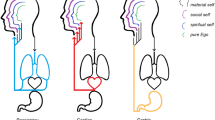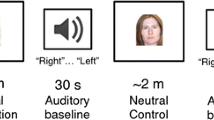Abstract
Human adults share ample experiences with their spouse and offspring. Do these experiences produce shared neural correlates of reflection on oneself and family members? We addressed this issue by scanning 14 Chinese middle-aged married couples, using functional MRI, during personality trait judgments of the self, one’s spouse, one’s child, and a celebrity. We found common activations in the medial prefrontal cortex (MPFC) during trait judgments of the self, spouse, and child compared to a celebrity. Self- and spouse-judgments also elicited overlapping activations in the ventral thalamus and caudate. Female and male participants showed comparable MPFC activity during child-judgments but females exhibited stronger MPFC activity during spouse-judgments compared to males. Our neuroimaging findings suggest that life experiences with conjugal family members during adulthood shape the functional organization of the brain and result in shared neural representations of oneself and conjugal family members during reflection on personality traits.




Similar content being viewed by others
References
Acevedo, B. P., Aron, A., Fisher, H. E., & Brown, L. L. (2012). Neural correlates of long-term intense romantic love. Social Cognitive and Affective Neuroscience, 7, 145–159.
Aron, A., Aron, E. N., Tudor, M., & Nelson, G. (1991). Close relationships as including other in the self. Journal of Personality and Social Psychology, 60, 241–253.
Aron, A., Fisher, H., Mashek, D. J., Strong, G., Li, H., & Brown, L. L. (2005). Reward, motivation, and emotion systems associated with early-stage intense romantic love. Journal of Neurophysiology, 94, 327–337.
Bartels, A., & Zeki, S. (2000). The neural basis of romantic love. NeuroReport, 11, 3829–3834.
Bartels, A., & Zeki, S. (2004). The neural correlates of maternal and romantic love. Neuroimage, 21, 1155–1166.
Cavanna, A. E., & Trimble, M. R. (2006). The precuneus: A review of its functional anatomy and behavioral correlates. Brain, 129, 564–583.
Chen, P. H. A., Wagner, D. D., Kelley, W. M., Powers, K. E., & Heatherton, T. F. (2013). Medial prefrontal cortex differentiates self from mother in Chinese: Evidence from self-motivated immigrants. Culture and Brain, 1, 3–15.
Cross, S. E., & Madson, L. (1997). Models of the self: Self-construals and gender. Psychological Bulletin, 122, 5–37.
Draganski, B., Gaser, C., Busch, V., Schuierer, G., Bogdahn, U., & May, A. (2004). Neuroplasticity: Changes in grey matter induced by training. Nature, 427, 311–312.
Eisenberger, N. I., & Cole, S. W. (2012). Social neuroscience and health: Neurophysiological mechanisms linking social ties with physical health. Nature Neuroscience, 15, 669–674.
Erickson, K. I., Voss, M. W., Prakash, R. S., Basak, C., Szabo, A., Chaddock, L., et al. (2011). Exercise training increases size of hippocampus and improves memory. Proceedings of the National Academy of Sciences USA, 108, 3017–3022.
Fisher, H., Aron, A., & Brown, L. L. (2005). Romantic love: An fMRI study of a neural mechanism for mate choice. Journal of Comparative Neurology, 493, 58–62.
Gabriel, S., & Gardner, W. L. (1999). Are there “his” and “hers” types of interdependence? The implications of gender differences in collective versus relational interdependence for affect, behavior, and cognition. Journal of Personality and Social Psychology, 77, 642–655.
Gogtay, N., Giedd, J. N., Lusk, L., Hayashi, K. M., Greenstein, D., Vaituzis, A. C., et al. (2004). Dynamic mapping of human cortical development during childhood through early adulthood. Proceedings of the National Academy of Sciences USA, 101, 8174–8179.
Guimond, S., Chatard, A., Martinot, D., Crisp, R. J., & Redersdorff, S. (2006). Social comparison, self-stereotyping, and gender differences in self-construals. Journal of Personality and Social Psychology, 90, 221–242.
Han, S., Gu, X., Mao, L., Ge, J., Wang, G., & Ma, Y. (2010). Neural substrates of self-referential processing in Chinese Buddhists. Social Cognitive and Affective Neuroscience, 5, 332–339.
Han, S., Mao, L., Gu, X., Zhu, Y., Ge, J., & Ma, Y. (2008). Neural consequences of religious belief on self-referential processing. Social Neuroscience, 3, 1–15.
Han, S., & Northoff, G. (2009). Understanding the self: A cultural neuroscience approach. Progress in Brain Research, 178, 203–212.
Han, S., Northoff, G., Vogeley, K., Wexler, B. E., Kitayama, S., & Varnum, M. E. W. (2013). A cultural neuroscience approach to the biosocial nature of the human brain. Annual Review of Psychology, 64, 335–359.
Harada, T., Li, Z., & Chiao, J. Y. (2010). Differential dorsal and ventral medial prefrontal representations of the implicit self modulated by individualism and collectivism: An fMRI study. Social Neuroscience, 5, 257–271.
Heatherton, T. F., Wyland, C. L., Macrae, C. N., Demos, K. E., Denney, B. T., & Kelley, W. M. (2006). Medial prefrontal activity differentiates self from close others. Social Cognitive and Affective Neuroscience, 1, 18–25.
Ho, D. Y. F. (1998). Interpersonal relationships and relationship dominance: An analysis based on methodological relationalism. Asian Journal of Social Psychology, 1, 1–16.
Huff, S., Yoon, C., Lee, F., Mandadi, A., & Gutchess, A. H. (2013). Self-referential processing and encoding in bicultural individuals. Culture and Brain, 1, 16–33.
Kelley, W. M., Macrae, C. N., Wyland, C. L., Caglar, S., Inati, S., & Heatherton, T. F. (2002). Finding the self? An event-related fMRI study. Journal of Cognitive Neuroscience, 14, 785–794.
Li, H. Z. (2002). Culture, gender and self-close-other(s) connectedness in Canadian and Chinese samples. European Journal of Social Psychology, 32, 93–104.
Liu, Y. (1990). Modern lexicon of Chinese frequently-used word frequency. Beijing: Space Navigation Press.
Ma, Y., Bang, D., Wang, C., Allen, M., Frith, C., Roepstorff, A., et al. (2014). Sociocultural patterning of neural activity during self-reflection. Social Cognitive and Affective Neuroscience, 9, 73–80.
Ma, Y., & Han, S. (2011). Neural representation of self-concept in sighted and congenitally blind adults. Brain, 134, 235–246.
Macrae, C. N., Moran, J. M., Heatherton, T. F., Banfield, J. F., & Kelley, W. M. (2004). Medial prefrontal activity predicts memory for self. Cerebral Cortex, 14, 647–654.
Markus, H. R., & Kitayama, S. (1991). Culture and the self: Implications for cognition, emotion, and motivation. Psychological Review, 98, 224.
Markus, H. R., & Kitayama, S. (2010). Cultures and selves: A cycle of mutual constitution. Perspectives on Psychological Science, 5, 420–430.
Moran, J. M., Lee, S. M., & Gabrieli, J. D. (2011). Dissociable neural systems supporting knowledge about human character and appearance in ourselves and others. Journal of Cognitive Neuroscience, 23, 2222–2230.
Moran, J. M., Macrae, C. N., Heatherton, T. F., Wyland, C. L., & Kelley, W. M. (2006). Neuroanatomical evidence for distinct cognitive and affective components of self. Journal of Cognitive Neuroscience, 18, 1586–1594.
Ng, S. H., Han, S., Mao, L., & Lai, J. C. L. (2010). Dynamic bicultural brains: A fMRI study of their flexible neural representation of self and significant others in response to culture priming. Asian Journal of Social Psychology, 13, 83–91.
Northoff, G., Heinze, A., de Greck, M., Bermpoh, F., Dobrowolny, H., & Panksepp, J. (2006). Self-referential processing in our brain—A meta-analysis of imaging studies on the self. NeuroImage, 31, 440–457.
Ochsner, K. N., Beer, J. S., Robertson, E. R., Cooper, J. C., Gabrieli, J. D., Kihsltrom, J. F., et al. (2005). The neural correlates of direct and reflected self-knowledge. Neuroimage, 28, 797–814.
Perogamvros, L., & Schwartz, S. (2012). The roles of the reward system in sleep and dreaming. Neuroscience and Biobehavioral Reviews, 36, 1934–1951.
Philippi, C. L., Duff, M. C., Denburg, N. L., Tranel, D., & Rudrauf, D. (2012). Medial PFC damage abolishes the self-reference effect. Journal of Cognitive Neuroscience, 24, 475–481.
Platek, S. M., & Kemp, S. M. (2009). Is family special to the brain? An event-related fMRI study of familiar, familial, and self-face recognition. Neuropsychologia, 47, 849–858.
Shi, Z., Ma, Y., Wu, B., Wu, X., Wang, Y., & Han, S. (2016). Neural correlates of reflection on actual versus ideal self-discrepancy. NeuroImage, 124, 573–580.
Smith, E. R., Coats, S., & Walling, D. (1999). Overlapping mental representations of self, in-group, and partner: Further response time evidence and a connectionist model. Personality and Social Psychology Bulletin, 25, 873–882.
Triandis, H. C. (1995). Individualism and collectivism. Boulder: Westview Press.
Wang, G., Mao, L., Ma, Y., Yang, X., Cao, J., Liu, X., et al. (2012). Neural representations of close others in collectivistic brains. Social Cognitive and Affective Neuroscience, 7, 222–229.
Xu, X., Aron, A., Brown, L., Cao, G., Feng, T., & Weng, X. (2011). Reward and motivation systems: A brain mapping study of early-stage intense romantic love in Chinese participants. Human Brain Mapping, 32, 249–257.
Zhang, Z. X. (2000). Chinese cognition on interpersonal relationship: A multi dimensional investigation. In C. F. Yang (Ed.), Interpersonal relationship, affection and trust of the Chinese: From an interactional perspective (pp. 159–179). Taipei: Yuen Liu Publishing Co.
Zhu, Y., Zhang, L., Fan, J., & Han, S. (2007). Neural basis of cultural influence on self representation. NeuroImage, 34, 1310–1317.
Acknowledgments
This work was supported by the National Natural Science Foundation of China (Project 31470986; 31421003; 91332125). We thank Michael Varnum for his helpful comments on this manuscript.
Author information
Authors and Affiliations
Corresponding author
Rights and permissions
About this article
Cite this article
Han, S., Ma, Y. & Wang, G. Shared neural representations of self and conjugal family members in Chinese brain. Cult. Brain 4, 72–86 (2016). https://doi.org/10.1007/s40167-016-0036-5
Accepted:
Published:
Issue Date:
DOI: https://doi.org/10.1007/s40167-016-0036-5




